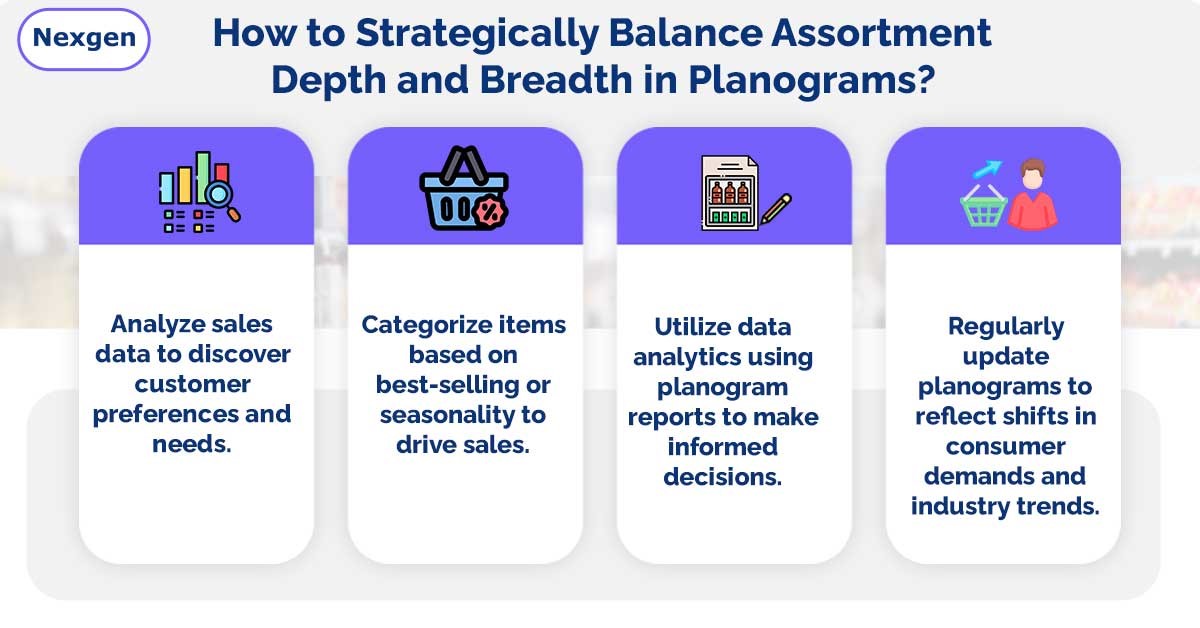In retail merchandising, visual merchandising planogram serve as the blueprint for organizing products within stores, aiming to enhance the customer experience and boost sales. A critical aspect of creating effective planograms lies in striking the right balance between assortment depth and breadth. Achieving this requires a strategic approach that considers consumer preferences, market trends, and store layout. Let us delve into the details of balancing assortment depth and breadth in planograms.
Understanding Assortment Depth and Breadth
Before delving into strategies, it is vital to grasp the definitions of assortment depth and breadth:
- Assortment depth: This refers to the variety and range of options available within a specific product category. It encompasses different flavors, sizes, colors, and variations of a particular item. For instance, within the skincare category, assortment depth may include various cleansers, moisturizers, and serums.
- Assortment breadth: It reflects the diversity of products available across different sections or departments within the store, such as clothing, electronics, groceries, and home goods.
Planogram Ways to Balance Assortment Depth and Breadth in Retail

- Know your customer base: Understanding your target audience is important. Analyze purchasing behavior, conduct market research, and gather customer feedback to identify their preferences and shopping habits. This insight will guide decisions regarding which products to prioritize and how to structure your shelf planning software effectively.
- Prioritize top sellers and seasonal items: Identify your best-selling products within each category and ensure they receive prominent placement within your planograms. These items are often the primary revenue drivers and should be readily accessible to customers. Additionally, consider seasonal variations in consumer preferences and adjust your assortment depth and breadth accordingly to capitalize on demand fluctuations.
- Adopt category management principles:Implementing category management principles can streamline your approach to assortment planning. Categorize products based on consumer needs and purchasing patterns. Allocate space within planograms based on category importance, sales performance, and strategic objectives. By treating each category as a separate section, you can optimize assortment depth and breadth while maintaining space within the shelf layout.
- Leverage data-driven insights:Utilize data analytics using planogram reports to make informed decisions about assortment planning. Analyze sales data, inventory turnover rates, and market trends to identify opportunities for optimization. For instance, cosmetic stores can increase the sales of sunscreen during the summer months by analyzing past sales data to adjust their assortment.
- Embrace flexibility and adaptability:Achieving the perfect balance between assortment depth and breadth is an iterative process. Continuously monitor sales performance, customer feedback, and market trends to identify areas for improvement. Be prepared to adjust planograms in response to changing consumer preferences, competitive pressures, and external factors such as economic conditions and industry trends.
Overview of Nexgen POG
Nexgen POG is a robust and user-friendly cloud-based visual merchandising tool. It is designed for quick and efficient planogramming with minimal effort. Planogram in retail can be designed by easily dragging and dropping the products. The multi-device compatibility feature of POG allows you to obtain, share and edit planogram on any device, including your phone. It helps in designing store-specific planograms for increased product visibility and sales.
Get Your Free Trial Now!